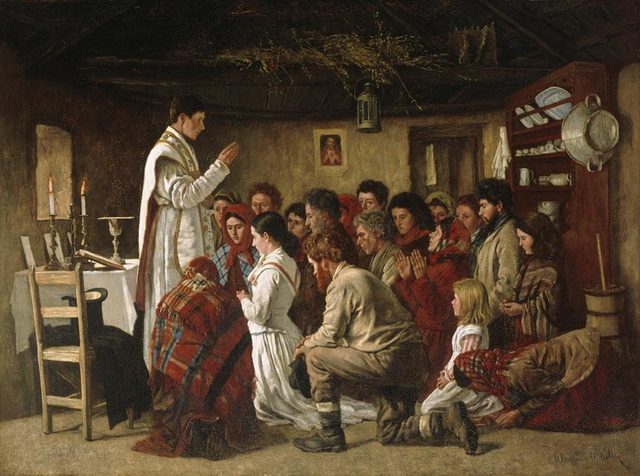Feast of Corpus Christi
This is my body. This is my blood
There is a painting in the National Gallery called Mass in a Connemara Cabin painted by artist Aloysius O’Kelly. It dates back to 1883 and is thought to be situated in Letterfrack parish in Connemara.

The painting depicts a young priest imparting a blessing at the end of Mass which he had celebrated with the occupants of the home in what was known as the custom of the Station Mass. The artist seems to have overcome the humble surrounds by discovering an inner richness which the painting exudes.
This richness is there in the richness of the colours the paint itself provides and the artistic skill of the play of light and contrast which gives a vivid quality to the painting.
The humble dwelling is transformed by the lighted candles on the kitchen table and a picture of the Sacred Heart seems to be a focal point drawing us in to the painting and wanting to tell us of the moment that has taken place in this humble setting – the celebration of Mass, the Eucharist, the Body and Blood of Christ, Corpus Christi and the promise of Christ which hangs in the air: “I am the bread of Life. Those who eat my flesh and drink my blood will live forever.”
More than this, the artist has depicted the deep faith of both the priest and his small congregation in a manner unique to each one of those present:
The young priest’s reverence is evident in his stance, his vestments and an overall sense of empathy that hangs in the air between him and the people with whom he has celebrated the Mass.
A vibrant agile looking man in his prime of life and dressed in his Sunday Clothes is on one knee in an act of deep respect – his vitality and energy stilled in a moment of respect for the divine.
An old woman is almost totally prostrate on the floor she is so consumed by her worship.
A young girl gazes upwards, her beauty meeting the beauty of amazement and wonder at this special moment.
Another old woman has her head part-hidden in a traditional red shawl as she bends in reverence and prayer.
In the background we see a fiery looking red-headed man whom one feels is not in his element in this confined space and yet he too seems becalmed, tamed almost by the atmosphere of sanctity around him.
All in all, it is a painting that captures the traditional reverence for the Mass that has passed down to each one of us to various degrees and modes of expression.
Ironically, during the pandemic technology brought the Mass into our homes in a new way. People were enabled to attend Mass in a variety of places.
One thing people missed was the ability to receive Holy Communion. Welcome as the mass online was/is people felt incomplete by not being able to receive Holy Communion.
That is what we celebrate today – Holy Communion, our unique uniting with Christ in his Body and Blood – Corpus Christi.
This feast in these still troubling pandemic times is a challenge to each of us on a personal level. Has the lockdown made me hunger and thirst more for the body and blood of Christ?
It is a question we answer for ourselves even though in a general way we may see it answered positively or negatively in the strength of people’s return to public worship.
Answering the question on a personal level is a reminder to us of the ongoing and constant need just now for personal responsibility as once more we re-emerge from lockdown.
No one has been unaffected by Covid-19 and lockdown. By concentrating on any one or a few groups who have been most affected by Covid and lockdown we mustn’t overlook the effects on each individual.
You, I, relatives, family, friends have all experienced its effects in some way. The reality is that its effects on us as individuals may not be discernible as yet and right now we don’t interpret our changed or changing behaviour as the effects of Covid-19.
In reality though, we have changed as a result of these times. In time, we will look back and see more clearly the psychological marks, the scars that the pandemic experience made on the exterior and inner self.
Now more than ever before we need sustenance and hope. The Eucharist – Holy Communion – is our sustenance and Hope. May our return to liturgical celebrations and our emergence from lockdown give us a renewed awareness of the strength of Holy Communion which feeds so much more than our physical needs but reaches into the hungry and thirsting soul of all humanity.
We must allow Christ the great artist paint the portrait of our souls as we worship in our churches and our homes and in the daily acts of life. May receiving the Body and Blood of Christ make us visibly renewed so that it will show in a transformed bigger portrait of life.